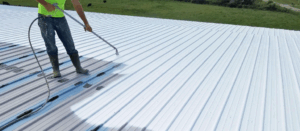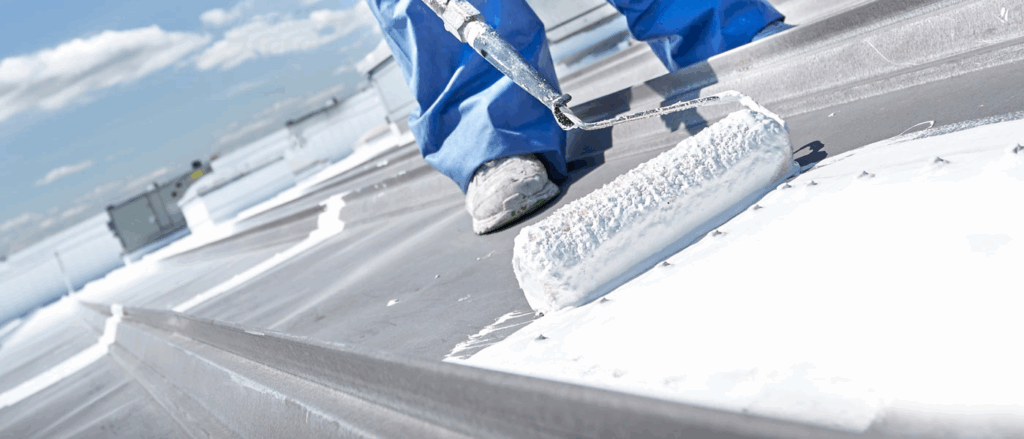Roof leaks are one of the most common and troublesome issues faced by homeowners and property managers. A leak can lead to extensive damage if not addressed promptly, including water intrusion, mold growth, and structural deterioration. One of the most effective preventative measures for keeping a roof watertight is the application of roof coatings. These coatings offer a protective layer that extends the life of your roof while significantly reducing the risk of leaks.
Understanding Roof Coatings
 Roof coatings are specialized formulations applied to the surface of an existing roof to enhance its durability and performance. They are typically made from materials like acrylic, silicone, polyurethane, or asphalt, each offering unique benefits based on the type of roof and the climate. Once applied, the coating forms a seamless, waterproof barrier that helps protect the roof from harsh weather, UV rays, and thermal expansion.
Roof coatings are specialized formulations applied to the surface of an existing roof to enhance its durability and performance. They are typically made from materials like acrylic, silicone, polyurethane, or asphalt, each offering unique benefits based on the type of roof and the climate. Once applied, the coating forms a seamless, waterproof barrier that helps protect the roof from harsh weather, UV rays, and thermal expansion.
Unlike full roof replacements, roof coatings are less invasive and more cost-effective. They serve as a restoration method, allowing the roof to maintain its structural integrity while improving its resistance to environmental elements. Over time, exposure to rain, sun, wind, and fluctuating temperatures can cause a roof to degrade, leading to cracks, blisters, and eventually leaks. A properly applied roof coating acts as a shield that slows down this degradation process.
How Roof Coatings Prevent Leaks
The main way roof coatings prevent leaks is by sealing and protecting the vulnerable areas of a roof. These vulnerable points include seams, joints, flashing, and previous repairs—places where water can most easily infiltrate. By creating a continuous membrane over the surface of the roof, coatings eliminate gaps and potential entry points for moisture.
In addition, most roof coatings are designed to remain flexible even after curing. This flexibility allows the coating to expand and contract with the roof during temperature changes without cracking. Traditional roofing materials, especially those that have aged, can become brittle and prone to cracking under thermal stress. The elasticity of roof coatings helps accommodate this movement and prevents the formation of new leaks.
Roof coatings also offer excellent UV resistance, which is critical in slowing the aging process of the roof membrane. Ultraviolet radiation from the sun can deteriorate roofing materials, making them more susceptible to water infiltration. A reflective roof coating not only shields the surface from UV damage but also reduces heat absorption, which helps in maintaining the roof’s condition over time.
Suitable Roof Types for Coating
Roof coatings are compatible with a wide range of roofing systems. Flat and low-slope roofs are particularly well-suited for coatings due to their tendency to collect standing water. Commercial buildings often have flat roofs that benefit significantly from coatings, especially in areas that receive heavy rainfall.
However, even sloped roofs can be treated with the appropriate type of coating, depending on the substrate. Metal roofs, for example, benefit greatly from coatings that prevent rust and seal seams. Modified bitumen, EPDM, TPO, and built-up roofs can all be effectively coated with formulations that are tailored to their material type.
It’s important to assess the condition of the existing roof before applying a coating. While coatings can seal minor cracks and imperfections, they are not a substitute for proper structural repairs. Any underlying damage should be addressed prior to coating to ensure long-lasting protection.

Maintenance and Reapplication
Roof coatings are not a one-time fix but rather part of a long-term maintenance strategy. Depending on the type of coating used and the environmental conditions, a roof may need to be recoated every five to ten years. Regular inspections can help identify signs of wear, such as thinning areas or loss of adhesion, indicating when reapplication may be necessary.
By incorporating roof coatings into a regular maintenance plan, property owners can prevent small issues from developing into major leaks. The cost of applying a roof coating is typically much lower than replacing an entire roof or repairing extensive water damage caused by a leak.
Environmental and Energy Efficiency Benefits
Beyond leak prevention, roof coatings offer additional advantages that support energy efficiency and environmental sustainability. Many modern coatings are formulated to be environmentally friendly, with low volatile organic compounds (VOCs) and energy-saving properties.
Reflective coatings reduce the roof’s surface temperature by reflecting sunlight away, which helps lower cooling costs in warmer climates. This added energy efficiency can be particularly valuable for commercial properties, where HVAC systems work overtime during the summer months. A cooler roof surface also contributes to urban heat island mitigation, making coatings a smart choice from an ecological standpoint.
